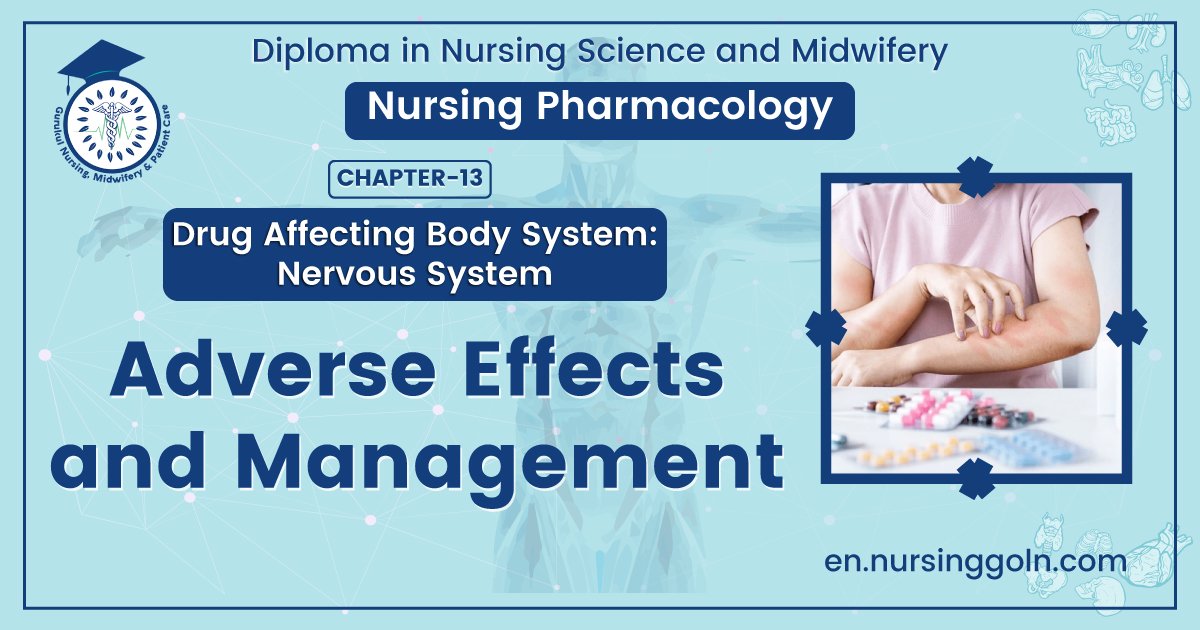Adverse effects and management – This book covers the entire syllabus of “Pharmacology” prescribed by BNMC- for diploma in nursing science & midwifery students. We tried to accommodate the latest information and topics. This book is an examination setup according to the teachers’ lectures and examination questions.
At the end of the book, previous questions are given. We hope in touch with the book students’ knowledge will be upgraded and flourish. The unique way of presentation may make your reading of the book a pleasurable experience.

Adverse effects and management
- Lowered blood pressure
- Dilated pupils
- Confusion or disorientation
- Slowed pulse and breathing
- Sleepiness or fatigue
- Difficulty urinating
- Dizziness
- Difficulty concentrating
- Memory loss
- Slowed reaction time
- Relaxation and euphoria
- Slurred speech
- Reduced inhibitions
- Loss of coordination
- Impaired judgment
- Blacking out
Management of CNS depressant overdose patient.
Management for CNS depression or CNS depressant overdose depends on the substances involved.
➤ Some CNS drugs have antidotes that can reverse their effects. These include Naloxone for opioid overdoses and Flumazenil for overdoses of benzodiazepine.
➤ A person may need emergency care if they are unaware that they are experiencing a CNS depressant overdose, especially after accidentally misusing their medication or due to a medical problem.
➤ Anyone witnessing signs of CNS depression or an overdose in another person should call the emergency services or local poison control center for guidance.
➤In these cases, treatment may include:
- Monitoring the person’s breathing and heart rate.
- Giving oxygen via an oxygen mask or respirator
- Administering stimulant drugs to increase a person’s heart rate
Central Neurotransmitters
A vast number of neurotransmitters are identified in the CNS. The most common neurotransmitters in the CNS are
- Acetylcholine
- Dopamine
- GABA
- Glutamate
- Glycine
- 5-HT (serotonin)
- Norepinephrine
- Histamine
- Opioid peptides
- Achykinins
- Endocannabinoids

Subtype, agonist and antagonist of CNS neurotransmitters:
| Neurotransmitters | Receptor Subtype And Agonists | Receptor Antagonist |
| Acetylcholine | M₁: muscarine M2: bethanechol Nicotinic: nicotine | Pirenzepine Atropine Dihydro- ß-erythrodine |
| Dopamine | DI D2: bromocriptine | Phenothiazine Butyrtyrophenones |
| GABA | GABAA: mususcimol GABAB: baclofen | Bicuculiine 2-OH saclofen |
| Glutamate | NMDA:NMDA AMPA:AMPA Kainate: kianic acid Metabotropic: ACPD | Dizoclipine CNQX MCPG |
| Glycine | Taurine. ẞ-alanine | strychnine |
| 5-HT (serotonine) | 5-HT IA :LSD 5-HT 2A: LSD 5-HT 3: 2-merhyl-5HT 5-HT4 | Metrogoline Ketanserin Ondansetron |
| Norepinephrine | a1: phenylephrine a2: clonidine B1: Isoproterenol B2: albuterol | Prazosin Yohimbine Atenolol Butoxamine |
| Histamine | H1: 2(m-fp) histamine H2: dimaprit H3: R-a-m-histamine | Mepyramine Ranitidine Thioperamide |
| Opioid peptides | Mu: bendorphin Delta: enkephalin Kappa: dynorphin | Naloxone Naloxone Naloxone |
| Opioid peptides | NK1: substance PNK2 NK3 | Aprepitant |
| Endocannabinoids | CB1:anandamide | Rimonabant |

Read more:
